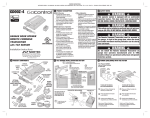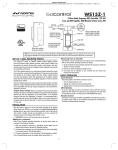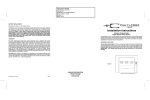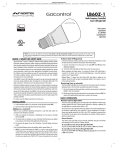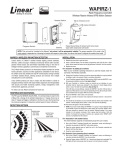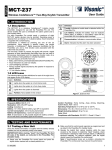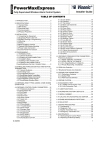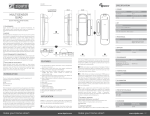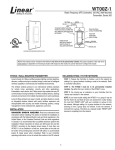Download PDF
Transcript
PRINTER’S INSTRUCTIONS: INSTR,INSTL,WADWAZ-1; LINEAR P/N: P2067 X1; INK: BLACK; MATERIAL: 20# MEAD BOND; SIZE: 8.500” x 11.000”; SCALE: 1-1; PAGE 1 OF 2 WADWAZ-1 Radio Frequency Controlled Wireless Door / Window Sensor NOTE: This unit must be “included in the Network” only where it will be permanently installed. The proper operation of this node in the mesh network is dependent on it knowing its location with respect to other nodes. You cannot “test bench” configure this module, then install. For “Inclusion” to (adding to) a network: Refer to your Controller operating instructions to add this module under the command of the Wireless Controller. WADWAZ-1 WIRELESS DOOR / WINDOW SENSOR Linear’s family of Z-Wave™ certified wireless lighting controls (switches, dimmers, outlets and plug-in modules) and Security devices (alert sounder, passive infrared sensor and door/window transmitter) brings a new level of intelligent wireless capability to commercial and residential environments. 1. Unscrew the screw fastening the rear cover and slide the rear cover down. 2. Insert a CR123A battery into the battery compartment and LED will start to flash slowly, which means the sensor has not yet performed “inclusion” with the Controller. 3. Prepare the Controller to include a unit to the network by adding it to a group (method of adding a node to the network). Refer to the Controller instructions. 4. If your Controller supports Network Wide Inclusion (NWI) locate the WADWAZ-1 near the proposed installation location. If not skip to Step 6. 5. With your Controller in Inclusion mode, you should see an indication on your Controller that the “device was included” in the network. It should display binary switch / Linear. The LED will stop blinking. Skip to Step 9. If the LED does not stop blinking, relocate the WADWAZ-1 to within 100 feet (line of sight) of a Z-Wave device or your hub and repeat Step 5. If the LED continues to blink, your Controller does not support NWI and continue with Step 6. 6. Place the WADWAZ-1 within 3 feet of the Controller. 7. With your Controller in Inclusion mode, depress the Program switch for 1 second then release. 8. You should see an indication on your Controller that the “device was included” in the network. It should display binary switch / Linear. The LED will stop blinking. 9. The device will appear in the list of Switches. ✓ NOTE: If you have trouble adding the WADWAZ-1 to a group it may be that the Home ID and Node ID were not cleared from it after testing. You must first “RESET UNIT” with your Controller to remove it from the network. Although adding it to a group includes it in the network, removing it from a group does not remove it from the network. If removed from a group, it functions as a repeater (only). “RESET UNIT” removes it completely from the network. The Z-Wave wireless protocol is an international wireless standard for remote home automation, security and other applications. Embedded in each device, the Z-Wave smart chip enables two-way RF communication among hundreds of Z-Wave enabled devices, allowing products and services from multiple manufacturers to work seamlessly. Linear Z-Wave products are easy to install, and allow dealers to create an integrated wireless network with nearly limitless expansion and interoperability with security and health monitoring systems, energy management, home entertainment, appliances, and more. The WADWAZ-1 sensor monitors a door or window and sends Z-Wave signals when the door is opened or closed. As part of a Z-Wave network, the WADWAZ-1 will also act as a wireless repeater to insure that commands intended for another device in the network are received. This is useful when the device would otherwise be out of the radio range of the wireless controller. For indoor use only. Retain instructions for future use. INSTALLATION If installing an entire Z-Wave system for the first time, refer to the installation guide of the Z-Wave Interface Controller before installing the door/window sensor. For “Association” with another device: The door/window sensor supports one association group with up to 5 nodes. 1. Set up the Z-Wave™ Interface Controller into “association” mode, and following its instruction to associate the WADWAZ-1 with another device. 2. Open the door/window sensor case to “wake” the unit. In the Controller, associate the sensor with the other device. 3. Close the door/window sensor case. M AL AGN IGN ET ME NT For “Exclusion” from (removing from) a network: 1. Set up the Z-Wave™ Interface Controller into “exclusion” mode, and following its instruction to delete the WADWAZ-1 from the Controller. 2. Press the Program switch of WADWAZ-1 for 1 second and release to be excluded. The LED light will flash continuously when the sensor is in the Exclusion condition. 3/4” MAXIMUM Magnet Gap Distance 1 PRINTER’S INSTRUCTIONS: INSTR,INSTL,WADWAZ-1; LINEAR P/N: P2067 X1; INK: BLACK; MATERIAL: 20# MEAD BOND; SIZE: 8.500” x 11.000”; SCALE: 1-1; PAGE 2 OF 2 Mounting INTEROPERABILITY WITH Z-WAVE DEVICES 1. Use the screws or adhesive tape to attach the rear cover to the frame along the opening edge of the door or window. 2. Attach the magnet to the door or window adjacent to the marks on the sensor (see illustration) BE SURE THE MAGNET IS NO FURTHER THAN 3/4” FROM THE SENSOR WHEN THE DOOR OR WINDOW IS CLOSED. A Z-Wave network can integrate devices of various classes, and these devices can be made by different manufacturers, just as the WADWAZ-1 can be incorporated into existing Z-Wave networks. PACKAGE CONTENTS • • • • • • WADWAZ-1 sensor with mounting bracket Magnet with mounting bracket Double-sided mounting tape CR123A Battery 4x Screws for mounting Installation Manual REGULATORY INFORMATION The WADWAZ-1 is certified to comply with applicable FCC and IC rules and regulations governing RF and EMI emissions. External Contact To monitor an additional opening, an external normally closed switch contact can be connected to the sensor’s external input terminals. This device complies with Part 15 of the FCC Rules. Operation is subject to the following two conditions: (1) This device may not cause harmful interference, and (2) This device must accept any interference received, including interference received that may cause undesired operation. 1. To allow clearance for the external contact wires, break out the thin plastic wall of the sensor case near the terminals. 2. Loosen the two terminal screws, insert the wires from the external contact into the two terminals and tighten the two screws. FCC Notice This equipment has been tested and found to comply with the limits for a Class B digital device, pursuant to Part 15 of the FCC Rules. These limits are designed to provide reasonable protection against harmful interference in a residential installation. This equipment generates, uses, and can radiate radio frequency energy and, if not installed and used in accordance with the instructions may cause harmful interference to radio communications. However, there is no guarantee that interference will not occur in a particular installation. If this equipment does cause harmful interference to radio or television reception, which can be determined by turning the equipment off and on, the user is encouraged to try to correct the interference by one or more of the following measures: • Reorient or relocate the receiving antenna. • Increase the separation between the equipment and receiver • Connect the equipment into an outlet on a circuit different from that to which the receiver is connected • Consult the dealer or an experienced radio/TV technician to help. • Changes or modifications not expressly approved by the party responsible for compliance could void the user’s authority to operate the equipment Terminal Screws IC Notice This Class B digital apparatus complies with Canadian ICES-003 BASIC OPERATION Cet appareil numérique de la classe B est conforme à la norme NMB-003 du Canada. Le présent appareil est conforme aux CNR d’Industrie Canada applicables aux appareils radio exempts de licence. L’exploitation est autorisée aux deux conditions suivantes : (1) l’appareil ne doit pas produire de brouillage, et (2) l’utilisateur de l’appareil doit accepter tout brouillage radioélectrique subi, même si le brouillage est susceptible d’en compromettre le fonctionnement. • During normal operation with the door or window closed, the detector’s red LED will be off. • When the magnet moves away from the sensor as the door or window opens, the sensor will send an alarm signal to any associated nodes and the red LED will flash once. • When the magnet moves back towards the sensor as the door or window closes, the sensor will send a restore signal to any associated nodes and the red LED will flash once. • The sensor is equipped with a tamper switch. If the sensor is removed from the mounting plate, it will send a tamper alarm signal and the red LED will light constant. See the table below for the alarm signal types and values. Alarm Type Alarm Event Alarm Level Internal Switch Tamper Switch External Switch Internal Switch Tamper Switch External Switch Internal Switch Tamper Switch External Switch Cet appareil numérique de la classe B est conforme à la norme NMB-003 du Canada. Operation is subject to the following two conditions: (1) this device may not cause interference, and (2) this device must accept any interference, including interference that may cause undesired operation of the device. WARRANTY This Linear product is warranted against defects in material and workmanship for twelve (12) months. This warranty extends only to wholesale customers who buy direct from Linear or through Linear’s normal distribution channels. Linear does not warrant this product to consumers. Consumers should inquire from their selling dealer as to the nature of the dealer’s warranty, if any. There are no obligations or liabilities on the part of Linear Corporation for consequential damages arising out of or in connection with use or performance of this product or other indirect damages with respect to loss of property, revenue, or profit, or cost of removal, installation, or reinstallation. All implied warranties, including implied warranties for merchantability and implied warranties for fitness, are valid only until Warranty Expiration Date as labeled on the product. This Linear LLC Warranty is in lieu of all other warranties express or implied. All products returned for warranty service require a Return Product Authorization Number (RPA#). Contact Linear Returns at 1-855-546-3351 for an RPA# and other important details. 0x07 0x02 0x03 0xFE Close: 0x00; Open 0xFF 0xFF Close: 0x00; Open 0xFF IMPORTANT !!! Linear radio controls provide a reliable communications link and fill an important need in portable wireless signaling. However, there are some limitations which must be observed. • For U.S. installations only: The radios are required to comply with FCC Rules and Regulations as Part 15 devices. As such, they have limited transmitter power and therefore limited range. • A receiver cannot respond to more than one transmitted signal at a time and may be blocked by radio signals that occur on or near their operating frequencies, regardless of code settings. SPECIFICATIONS Battery Frequency Operating Temp Repeater Range Copyright © 2014 Linear LLC • Changes or modifications to the device may void FCC compliance. • Infrequently used radio links should be tested regularly to protect against undetected interference or fault. CR123A Lithium Battery 908.42 MHz 5°F~140°F / -15°C~ 60°C Yes Up to 100 feet line of sight between the Z-Wave Controller and/or the closest Z-Wave Repeater • A general knowledge of radio and its vagaries should be gained prior to acting as a wholesale distributor or dealer, and these facts should be communicated to the ultimate users. 2 P2067 X1



